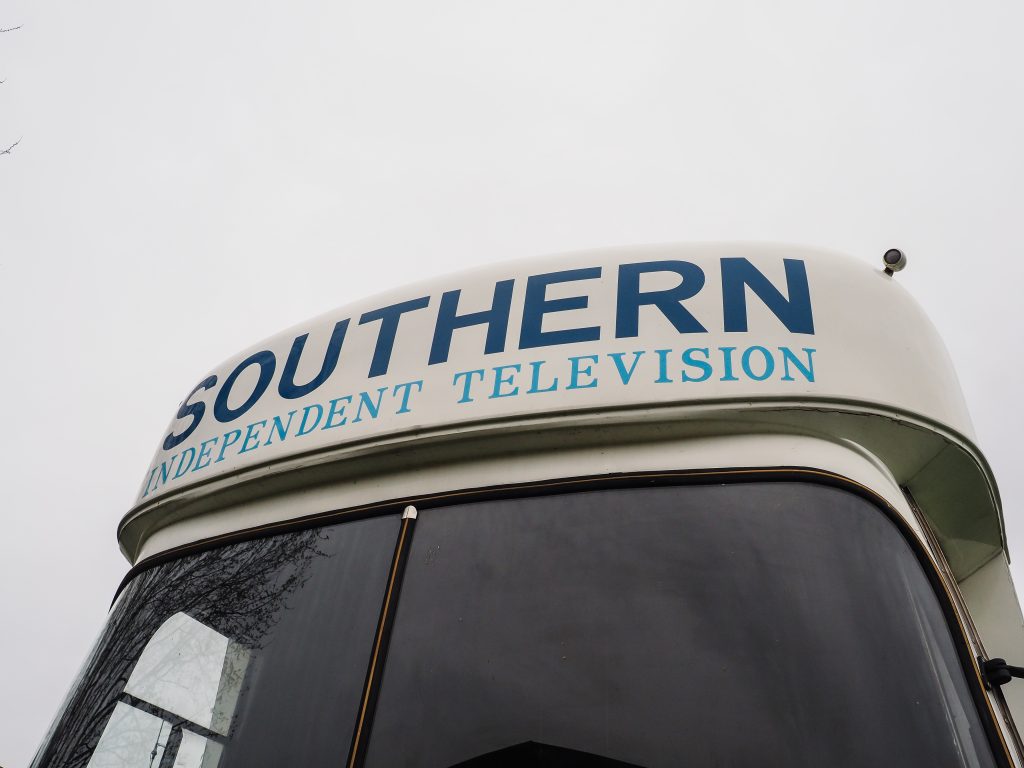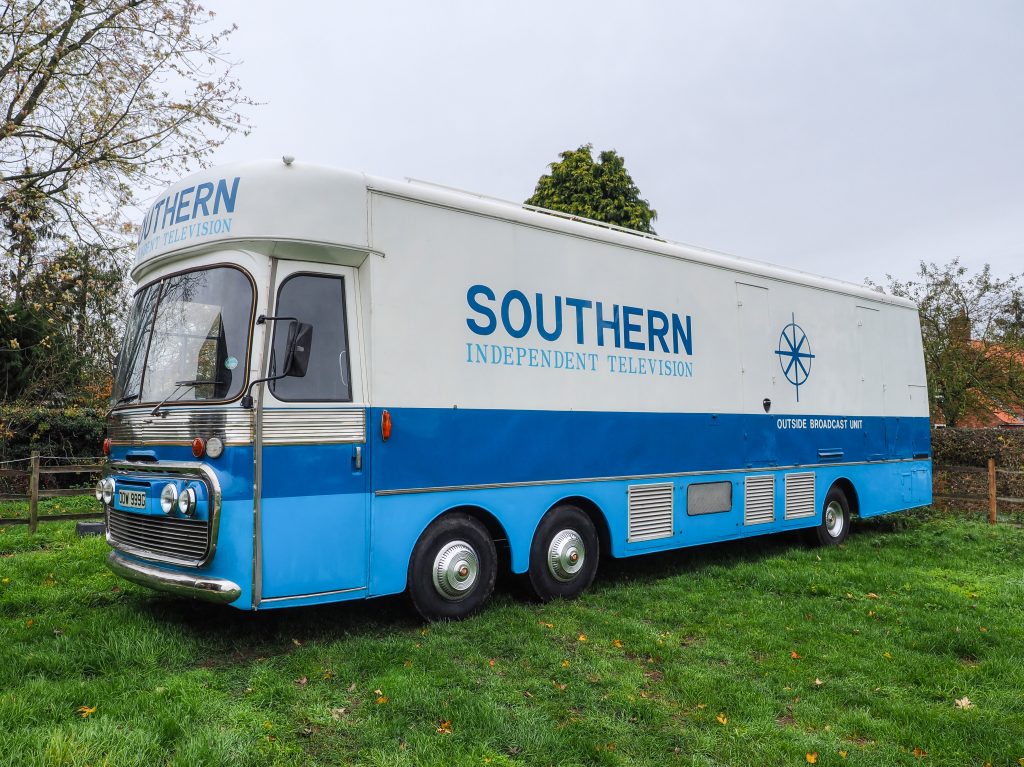
When bought for preservation, this Bedford VAL TV Outside Broadcast Unit was a tatty empty shell. Now, though, it’s been restored, houses a full set of period equipment, and it all works! Peter Simpson tells the story.
Dr Paul Marshall, who owns this Bedford VAL outside broadcast unit, is an avid collector of old/period Television equipment. He is also Chairman of the Broadcast Engineering Conservation Trust, a charitable organisation dedicated to the preservation of TV’s past for future generations. Items from Paul’s collection are forming the nucleus of a new dedicated museum which the trust are putting together in Lincolnshire.
I’ll come back to that a bit later though. Our main interest, obviously, is Paul’s vehicles, and the Bedford featured here is one of three Outside Broadcast Units (or OBUs) that Paul owns. The others being an ex-BBC Commer with Marshall bodywork, and a former Yorkshire/Tyne-Tees Bedford KM with bodywork by RTS of Hackney. Several other OBUs survive in preservation; BECG members own eight in total.
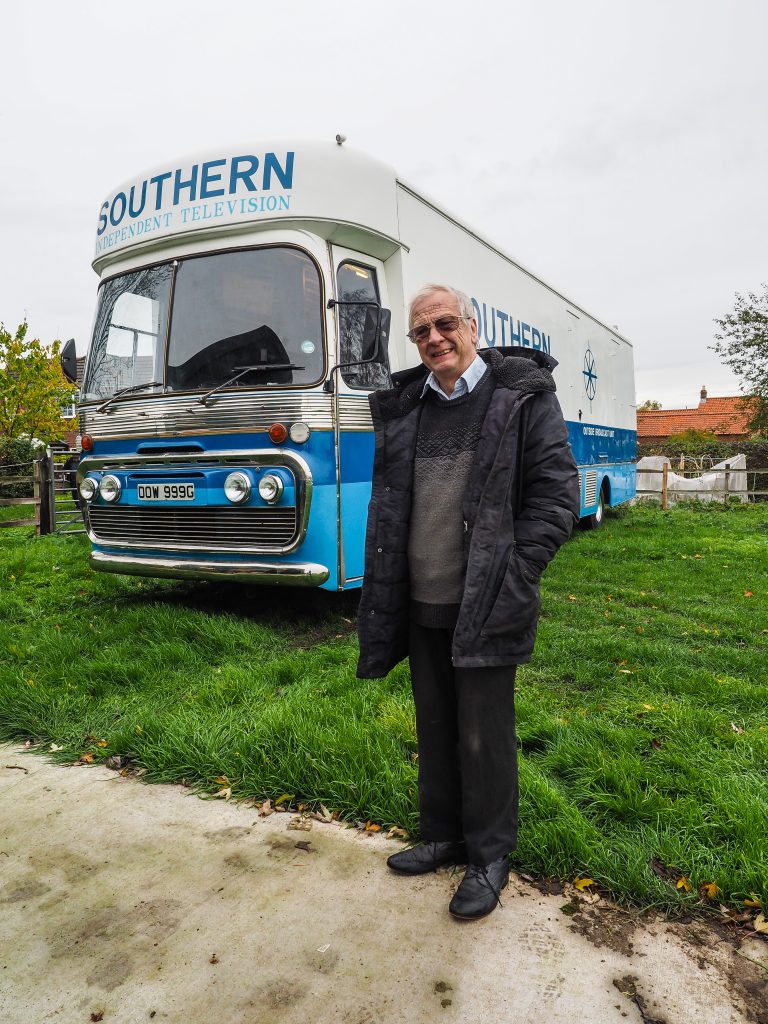
Bedford VAL OOV999G is probably the pride of Paul’s collection though. When built, in 1968/69, it cost around £250,000. That’s equivalent to nearly £3.5million in 2025. It was a truly stare of the art piece of kit. It’s also the oldest operational colour OBU left. Southern (“the Station that Serves the South”) was one of the smaller ITV companies. It was also generally considered fairly conservative in outlook. So having it was very definitely a feather in their cap.
VAL first diesel OBU
Known when in TV service as ‘Big Bertha’, OOV has a Bedford VAL coach chassis with Bedford 466 diesel, five-speed gearbox and a two-speed rear axle. It also, unusually, has power steering. It was one of, if not the, first diesel powered OBUs. Until that point petrol engines were preferred as it was felt that the vibration from a diesel could damage the valves within the broadcast equipment. Big Bertha, however, was kitted out with solid-state transistorised equipment. The Plaxton coach front panel gives the impression of a converted coach, but the body is totally brespoke, and was built to Southern Television’s specifications by Dell of Southampton. As originally supplied, it came with a single-piece windscreen, the current split-screen arrangement being added later.
As the vehicle was built for a long life, and Southern Television’s main base was on the Southampton waterfront, most of the body is made from glass-fibre, with the lower lockers and so on made from aluminium. At the time, the glass-fibre panels were claimed to be the largest that had been made in Europe.
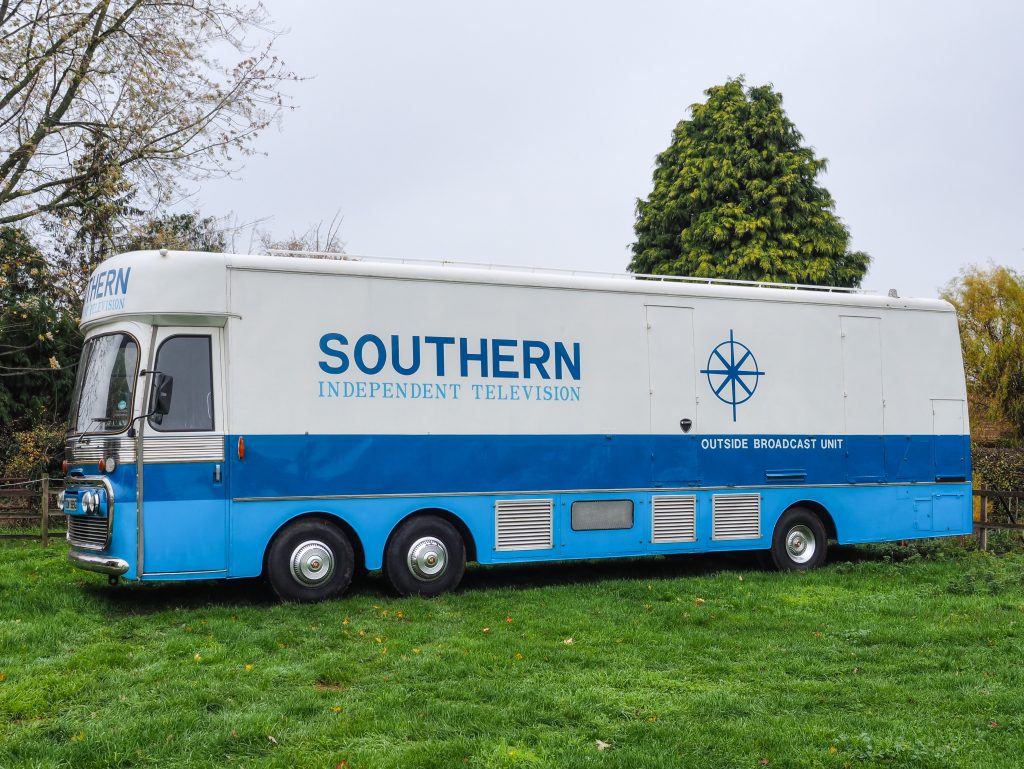
The internal layout was also state of the art. Until the late 1960s, BBC and ITV Outside Broadcast units had traditionally been laid out front-to-rear with operator’s desks across the vehicle, and the crew facing forwards.
Forward thinking, sideways facing
However ATV (who, in contrast to Southern, were probably the most forward-thinking ITV company), had tried a front to rear layout with success. Southern TVs Head Engineer Basil Bultitude who had previously worked for both BBC and Associated Rediffusion copied that layout for Southern’s OBU. It worked, and soon became industry-standard.
Big Bertha operated for a very short time as a black-and-white OBU but it was soon converted to full colour. Most of the equipment was supplied by Marconi, including four Marconi MkVII cameras. These were a popular choice for OB work.
Big Bertha’s first big job was helping to provide ITV’s coverage of the 1969 Investiture of Prince Charles as Prince of Wales at Caernarvon Castle. It was also used regularly covering horse racing within Southern’s patch, plus royal visits and major news stories. The Bedford VAL was also used on some of Southern’s own television programmes. Relatively little of Southern’s adult output was ‘networked’ across the ITV network. Several children’s programmes were however.
Networked Output
Big Bertha was involved with “Freewheelers”. This was a spy/action/adventure series in the style of The Avengers and Department S, broadcast between 1969 and 1973. Though for young teenagers, Freewheelers had the same scriptwriting and production standards as adult programming. Numerous outside locations across Southern England and the near-continent were used.
Big Bertha was updated regularly. In 1980 it was given a full internal refit with up-to-date equipment and new cameras. In 1981, Southern lost their franchise to TVS and the VAL was transferred. Apart from a bew livery, very little else changed. In the mid-1980s Sony cameras arrived. From 1993, TVS was replaced by Meridian TV. By this point television companies had largely switched to independent contractors for their OB requirements. This was more cost-effective than owning and running their own equipment. Big Bertha grsadually fell out of use, and never received Meridian branding.
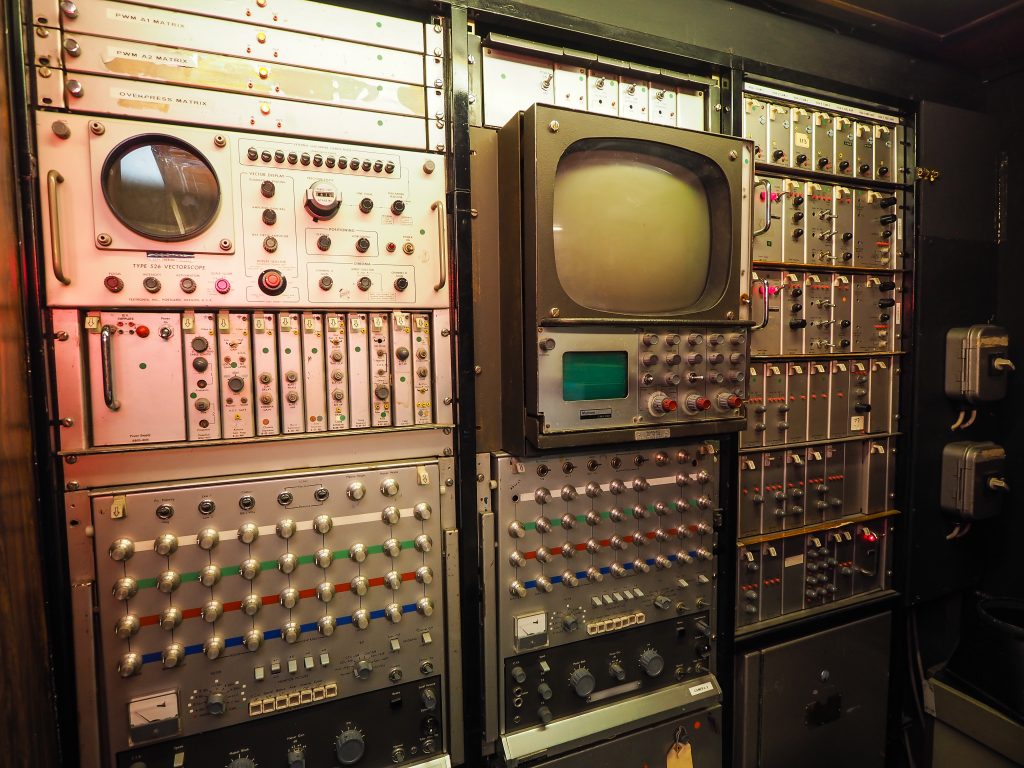
In 1994, Paul was given the ‘nod’ that Big Bertha was available to buy. There was a strong wish among Meridian’s staff – many of whom were ex Southern/TVS – that their OBU should go to a good home. Having seen the work that Paul had done on others, Meridian gave it to him.
Bedford VAL Restoration
As acquired, Big Bertha was little more than an empty shell. Most of the internal equipment had been removed for reuse elsewhere. On the positive side however, the mechanical and structural side was in good order. There was one mechanical issue which won’t surprise anyone who has worked on VALs. It was the brakes. Balancing the front two axles is tricky, and the parking brake also operates on the front wheels. Paul and the team also renwed numerous brake pipes and hoses and fitted new tyres all round. At one time Bedford VAL tyres were scarce, but apparently this is no longer the case.
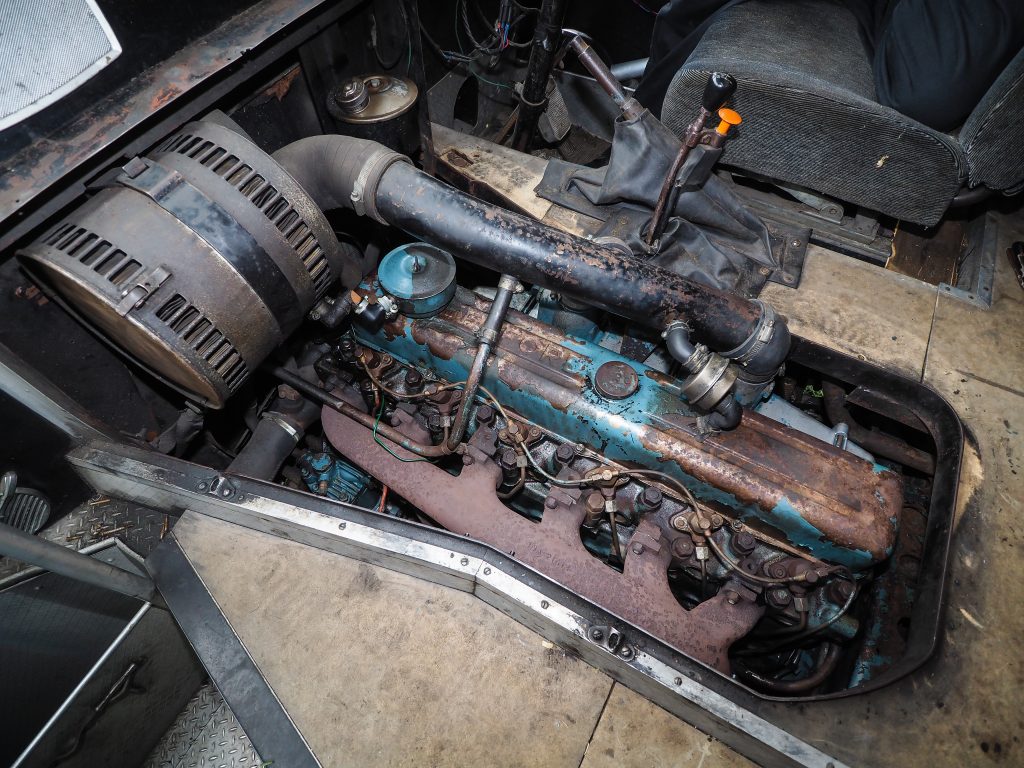
The engine, transmission and other running gear required little more than routine servicing and oil/filter changes. The body, being largely glass-fibre, wasn’t rusty so needed little work prior to repaint in the distinctive original livery using contemporary photos as a guide. With the ‘lorry’ side of his vehicles maintenance and restoration Paul is assisted by Sam Booth. Sam is a retired garage owner and former AA patrol. He also holds an HGV driving licence allowing him to drive the OBUs to events and so on.
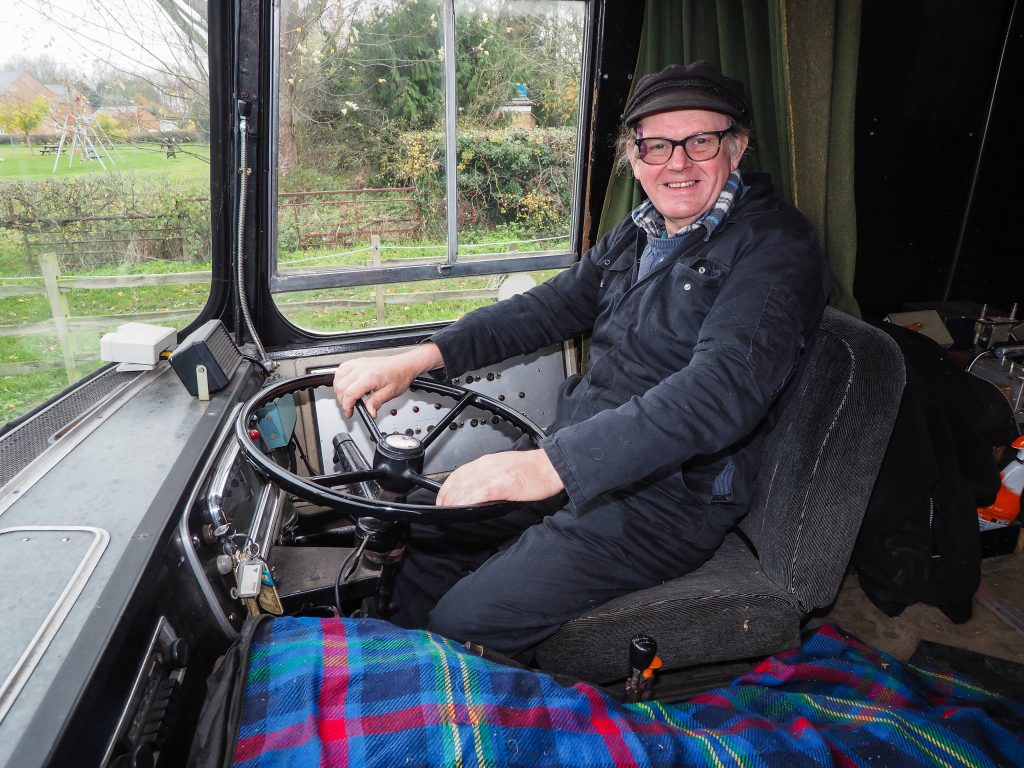
Bedford VAL Internal fit-out
And that just left the interior… Here, as outside, Paul’s aim was to return Big Bertha to as near her 1969 build-spec as possible. Some of the kit came from as far afield as Australia, but a lot is stuff that he already had. It’s all fully-operational. At shows the vision mixing desk can be connected to cameras outside. This allows visitors to see how location TV broadcasts were made. THe BECT have made one change. The colour TV monitors are slightly too new as the originals, being new technology at the time, tended to overheat.
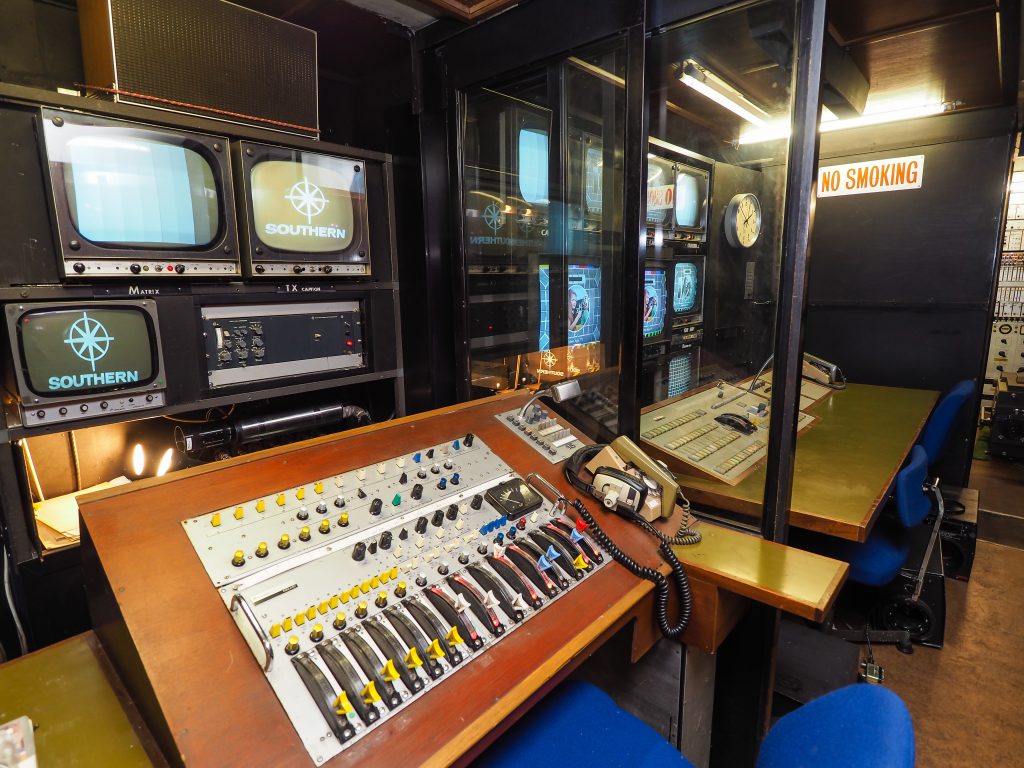
And that, in essence is the story so far. Big Bertha appears at shows regularly – including ten years at the Lincoln Steam Rally. On the road, she’ll cruise at 60mph – though “it takes a long time to get there.” Fuel consumption seems to be around 8mpg.
Big Bertha does also sometimes return to television work. These days however her role is on the other side of the camera, in period dramas set in the sixties and seventies. Recent appearances have included four episodes of ‘The Crown’, and an episode of Endevour where she was televising an ‘It’s a Knockout’ type event. Paul and fellow enthusiast Dicky Howett have set up Golden Age TV, through which the vehicles plus items from the pair’s collection of studio and other TV equipment is available to hire for film work and similar. To find out more, and to get some idea of the size of these collections, go to www.golden-agetv.co.uk
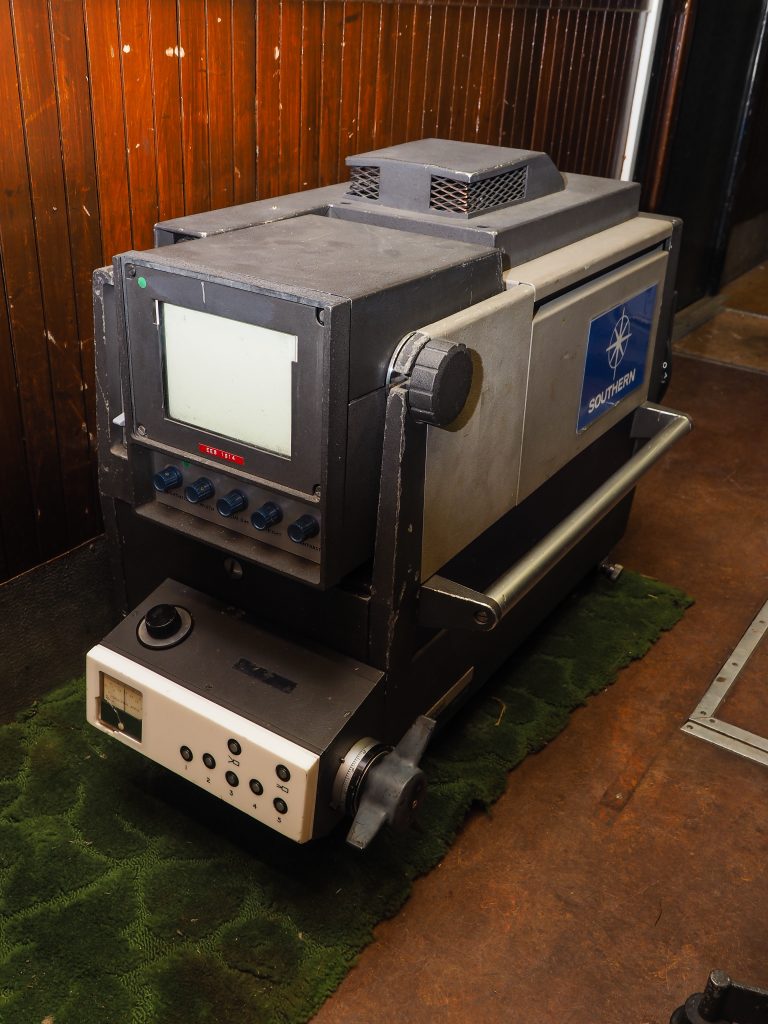
Broadcast Equipment Conservation Trust
As noted earlier, Paul is Chairman of the Broadcasting Engineering Conservation Group, who are in the process of creating a major museum dedicated to the history of television broadcasting equipment. The BECG started in 2018 when, in order to take Big Bertha to the at RAF Scampton, a corporate identity was required. From here, other enthusiasts quickly joined up and in 2019 the BECG became a registered charity. From here, the idea of a museum quickly developed. There were two main reasons for this; one was with the members all being ‘of a certain age’ there was concern about what would happen to their collections once they were no longer around. But more importantly, it was felt that there was need for a museum telling the story of TV broadcasting through the equipment used.
The first thing needed was, of course, a home. The size of building required and the funding available dictated a north of England location, and initially premises near Grimsby were found but fell through. Then, via an out-of-area estate agent advertisement, the group learnt that the former Sergeant’s Mess at RAF Hemswell near Gainsborough was up for sale.
Museum at Hemswell
Hemswell closed as an RAF base in 1967, and much of it has since been redeveloped as the largest antique centre in Europe with numerous traders and outlets catering for most tastes. The Sergeant’s mess had variously been a pub and community centre, but had been empty, neglected and vandalised for over ten years. However the building included 30,000sq.ft of space plus two acres of outside space. It was also in a location that already attracted thousands of visitors. The mess also includes a large ballroom which is highly suited to conversion into undercover storage for OBUs and other TV Engineering vehicles.
Much work has been done already; the building is now essentially watertight, many artefacts are already on site, and more are expected from members collections. The museum is not yet open to the public regularly, though pre-booked visits by special-interest groups can be arranged. Additionally, a special one-off open day was held on September 18 as part of the nationwide Heritage Open Days programme, and extremely well supported. Further progress is ongoing, and the people behind this project are clearly very enthusiastic, however as with most projects of this kind, funding and help are always welcome. To find out more, arrange visits or offer support, go to https://becg.org.uk/
To read more articles like this every month, subscribe to Classic & Vintage Commercials magazine by subscribing here. And find the latest news, exclusive looks and more at the CVC website here.
